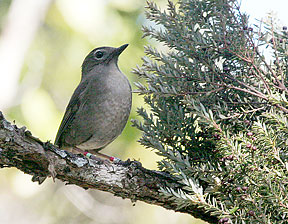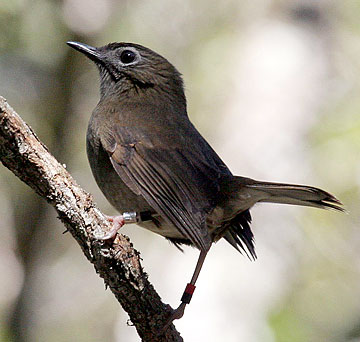
COURTESY ERIC VANDERWERF / PACIFIC RIM CONSERVATION
A puaiohi perched on a pukiawe branch in the Alakai Wilderness after its release Feb. 4. Another group of nine birds are to be released today or tomorrow. The birds feed on the berries of the pukiawe in the wild. CLICK FOR LARGE
|
|
Birds freed in Kauai forest to fight for species' survival
Puaiohi are among the few natives that adapt to the wild
Today or tomorrow, depending on the weather, nine endangered puaiohi birds that were raised in captivity will be set free in Kauai's remote Alakai Wilderness.
As the small gray-brown birds fly off into the rain-soaked ohia forest, they'll be facing the toughest days of their lives.
"Most mortality occurs right after release," said Pauline Roberts, coordinator of the Kauai Forest Bird Recovery Project. Instead of being fed several times a day, the birds will have to forage for themselves.
HELP THE BIRDS?
Donations made to the San Diego Zoo can be directed to the "Hawaii Program." The bird program receives 100 percent of all donations. You can also ask state and federal lawmakers to fund bird conservation programs.
VISIT THE BIRDS?
The San Diego Zoo's Hawaii Endangered Bird Conservation Program holds an annual open house at its Big Island facility in late November or early December. E-mail alanlieberman@earthlink.net for information.
HEAR THE BIRDS?
CLICK HERE to hear an audio clip of puaiohi birds in the wild from the CD "Voices of Kauai Forest Birds," by David Kuhn. The CD can be purchased at soundshawaiian.com.
ON THE NET
» Hawaii Forest Bird Recovery Project
» San Diego Zoo Hawaii Birds Project
|
"The foods are new, the weather harsher. They've never flown such large distances before. They've never seen a rat," one of their most dangerous predators, Roberts said. "It's a steep learning curve."
Yet the petite bird also known as the small Kauai thrush has done well.
It is one of the success stories in progress among the 35 threatened or endangered native Hawaiian bird species. The effort to save the birds includes raising them to add to wild bird populations and improving their habitats by removing predators and alien plants and animals.
There are an estimated 300 to 600 puaiohi on Kauai, the only place they have ever been found.
Since 1999, conservation biologists have released 132 puaiohi birds into the wild, said Alan Lieberman, program director of the San Diego Zoo's Hawaii Endangered Bird Conservation Program. The program receives about $900,000 a year from state and federal agencies to raise five species of Hawaiian endangered birds from eggs for release to the wild.
"We are just part of the army that's trying to make the big difference," Lieberman said of his team of 13 people and its partners: the U.S. Fish & Wildlife Service, state Division of Forestry and Wildlife (part of the Department of Land and Natural Resources), the U.S. Geological Survey's biological branch and private landowners.
"Mother Nature is a wonderful thing," Lieberman said. "A chick raised in a cup with tissue paper" and released into the wild, "within a month picks up the right nesting material, goes to a niche in cliff wall and makes a nest. ... They just know."

COURTESY THE SAN DIEGO ZOO
The puaiohi, or small Kauai thrush, is one focus of an intense conservation effort by a partnership between the U.S. Fish and Wildlife Service, the state of Hawaii and the San Diego Zoo's Hawaii Endangered Bird Conservation Program. Here, conservationists bring puaiohi to a release site. CLICK FOR LARGE
|
|
Yet all Hawaii's native birds, even those not listed as endangered, face an uphill battle. Of more than 140 native species and subspecies known to have existed before humans came to Hawaii, half are gone. Of the 71 survivors, 15 teeter on the brink of extinction, with 500 or fewer animals in the wild. A number of those birds haven't been sighted in years and could be gone already.
Hawaii's native birds have struggled against increasing odds in the face of alien threats to their island paradise. These include:
» Mosquitos, which can spread malaria and avian pox that have killed many native birds.
» Pigs, sheep and goats, which destroy native plant life.
» Rats, mongoose, cats and dogs, which prey on native birds and their eggs and young.
Lieberman emphasizes that his program "does not put any wild bird population at risk. We've taken eggs, not live birds." All 230 puaiohi raised in captivity are descendants of the original 14 fertile eggs taken from wild birds' nests in 1996-97.
Any captive raised birds that survive add to the wild bird flock. Scientists in the field have observed puaiohi released in prior years raising families of their own, having bred with both wild and fellow captive-bred birds.

COURTESY ERIC VANDERWERF / PACIFIC RIM CONSERVATION
A puaiohi perches on a branch in the Alakai Wilderness of central Kauai just moments after its release Feb. 4. Freeing of captive-raised birds since 1999 has increased the highly endangered bird's population on Kauai, the only place it exists in the world. CLICK FOR LARGE
|
|
Of the five bird species raised in captivity and released to the wild, the palila, nene goose and puaiohi have done well.
The alala (Hawaiian crow) has no wild population, and whether the 52 captive birds can ensure its survival remains uncertain.
A new program to raise Maui parrotbill is too new to assess, but the hope is to establish a second wild group, as was done with the palila on the Big Island.
"It's a great privilege to be here and do conservation work," said Roberts, who spends hours tracking puaiohi in the rainy Alakai wilderness via tiny radio transmitters.

COURTESY ERIC VANDERWERF / PACIFIC RIM CONSERVATION
The endemic puaiohi, or small Kauai thrush on Kauai, the only place it exists in the world. CLICK FOR LARGE
|
|
The bird, which is "bigger than a canary but smaller than a zebra dove ... could be sitting in a tree right next to you and you wouldn't see it," Roberts said.
Roberts notes that the kamao, or large Kauai thrush, has not been seen since 1989. Some might still exist. Or not.
"That's what I don't want to happen to the puaiohi," Roberts said. "This is a species that has lasted thousands and thousands of years. It would be so hard to lose them. I don't want to even consider it as possibility."

